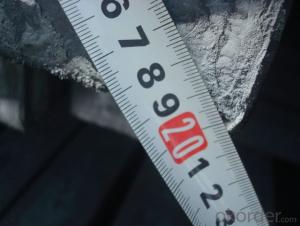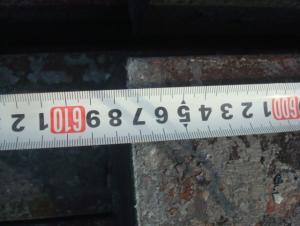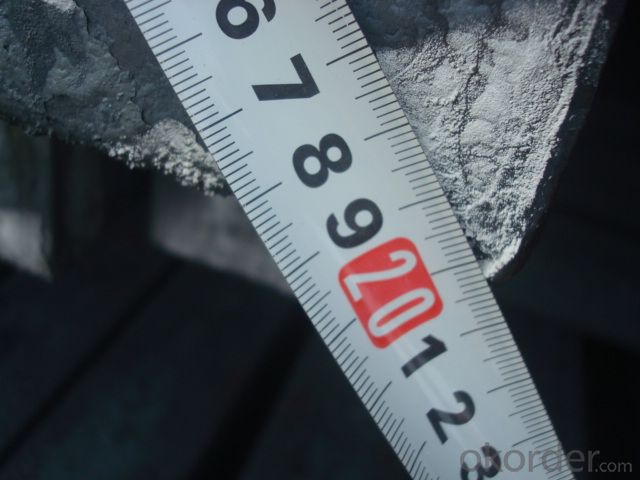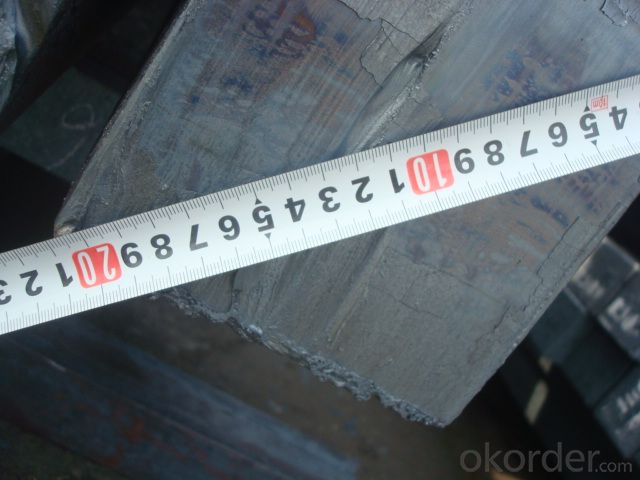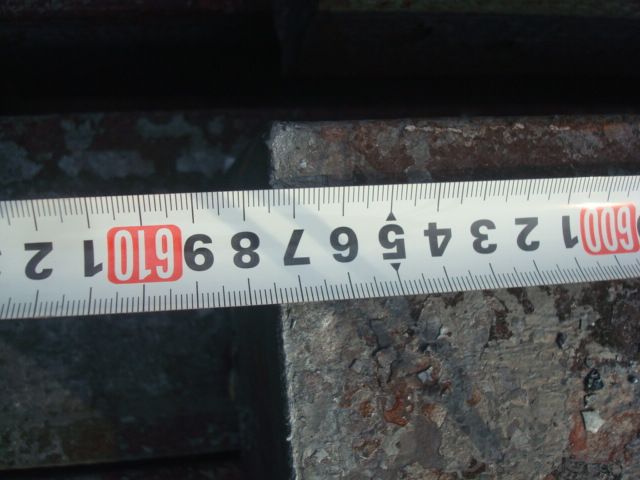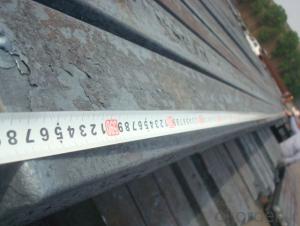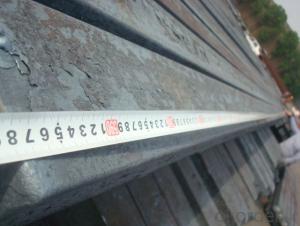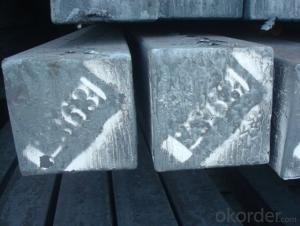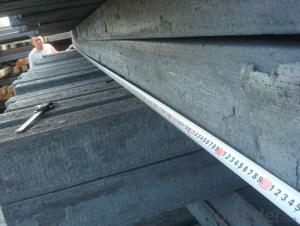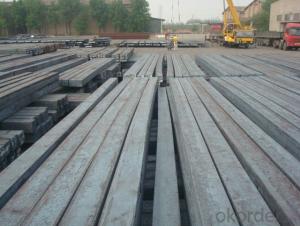Continue Casting Steel Billets/Blooms By Blasting Furnace
- Loading Port:
- Qingdao
- Payment Terms:
- TT OR LC
- Min Order Qty:
- 1000 m.t.
- Supply Capability:
- 10000 m.t./month
OKorder Service Pledge
OKorder Financial Service
You Might Also Like
Continue Casting Steel Billets/Blooms By Blasting Furnace
1.Structure of Continue Casting Steel Billets/Blooms By Blasting Furnace
Continue Casting Steel Billet Manufactured By Blasting Furnace is the raw material of all kinds of steel mill. Billet section of square, round, flat, rectangular and abnormity, etc Several, mainly related to shape of rolled products. Simple rolled section steel, choose cross section of square billet or rectangular billet. rolling The sector products such as flat steel, Angle steel, select the rectangular billet or slab. Had better profiled billet when production beams, channels, and in rolling process Lines and improve the yield. The raw material of round billet is the production of seamless tube.
2.Main Features of ContiContinue Casting Steel Billets/Blooms By Blasting Furnace.
Continue Casting Steel Billet Manufactured By Blasting Furnace section size should meet the requirements of rolling deformation and finished product quality, but also roll strength and biting condition of restrictions. General steel Billet section height H. And the roll diameter D The ratio of the ( namely H/D) Should be less than or equal to zero 0.5 . Length of steel billet by finishing temperature, Rolling time and the length of the product Or times ruler. When heated too long accident prone to bump the furnace wall of steel, too short, furnace bottom utilization rate is not high, influence the heating furnace production. For the production Choose a variety of steel and steel billet, should consider the affinities of billet, as far as possible in order to improve the productivity of the roughing mill, simplify the stock management of workshop.
3. Continue Casting Steel Billets/Blooms By Blasting Furnace Images

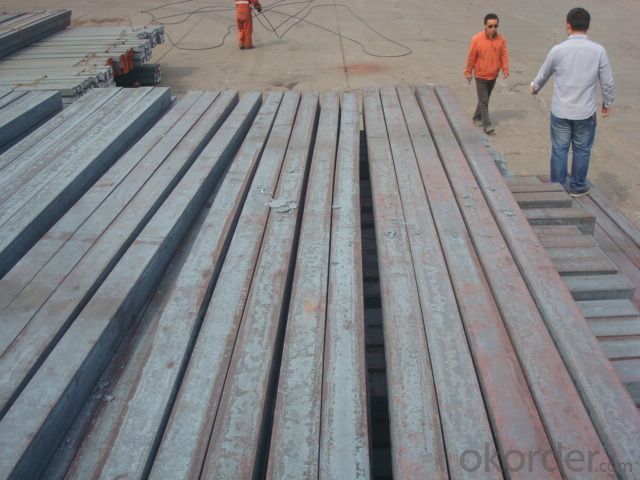
4. Continue Casting Steel Billets/Blooms By Blasting Furnace Specification
Slab: cross section width and height of the ratio of the larger, mainly used for rolling plate. Billet: equal cross section width and height, or a huge difference, mainly used for rolling steel, wire rod.
Material standard The editor Range of thickness: 150-240 - mm + / - 5 mm width range: 880-1530 - mm + / - 20 mm Length: 3700-10000 - mm + / - 500 - mm Cross-sectional size: 64 * 64; 82 * 82; 98 * 98; 124 * 124; 120 * 150; 152 * 164; 152 * 170 mm Length: 9000 mm Section of tolerance: billet: 1.0 + / - 2.0-1.0 + / - 1.0 mm slab: width: + / - 2.0 mm thickness: + / - 3.0 mm The length tolerance: + / - 200 mm Section diagonal tolerance: 3.5-8.0 MM Billet section size protrusions requirements: < 1242 mm, do not allow; > = 1242 mm, < = 2 mm 1242 mm, < = 3 mm Beheading (shear) extension deformation: < 1242 mm billet: no control; The slab: < = 15 mm Surface tilt: no more than billet section 0.1 Bending: every 1 m length is not more than 10 mm The distortion: length < = 5 m, < = 11. ; The length of the < = 7.5 M, < = 5. Material % 3 sp/PS chemical composition: C Mn Si S P
There are three shapes of the steel billets: square billet, slab, rectangular billet The Chinese billet, rectangular billet is mainly suitable for rolling hot rolled strip, building reinforced bar, Ordinary wire, high speed wire rod and various small profile. Of the slab are mainly used for rolling plate and hot coil sheet.
5.FAQ of Continue Casting Steel Billets/Blooms By Blasting Furnace
We have organized several common questions for our clients,may help you sincerely:
①How about your company?
A world class manufacturer & supplier of castings forging in carbon steel and alloy steel,is one of the large-scale professional investment casting production bases in China,consisting of both casting foundry forging and machining factory. Annually more than 8000 tons Precision casting and forging parts are exported to markets in Europe,America and Japan. OEM casting and forging service available according to customer’s requirements.
②How to guarantee the quality of the products?
We have established the international advanced quality management system,every link from raw material to final product we have strict quality test;We resolutely put an end to unqualified products flowing into the market. At the same time, we will provide necessary follow-up service assurance.
③How is the packaging and delivery?
Loose by Vessel and the delivery term is based on the the quantity and our factory’s schedule then.
- Q: What are the main factors affecting the tensile strength of steel billets?
- The main factors affecting the tensile strength of steel billets include the chemical composition of the steel, the heat treatment process, the presence of impurities or defects in the material, the grain size and orientation, and the processing conditions used during manufacturing.
- Q: What are the potential applications of steel billets in the textile aftermarket?
- Steel billets have limited potential applications in the textile aftermarket due to their heavy and rigid nature. However, they can be used as weights for fabric stretching or as support structures for heavy machinery in textile factories.
- Q: How are steel billets used in the production of marine vessels?
- Steel billets serve as a crucial element in the manufacturing process of marine vessels. They are utilized as raw materials for the production of different structural components and parts needed for the vessels. To begin with, the steel billets are melted and cast into diverse shapes and sizes, depending on the specific requirements of the vessel. These billets are commonly converted into plates, beams, channels, and sections, which are essential for the overall structure of the vessel. These steel components are used in the construction of the hull, which is the primary body of the ship responsible for providing the necessary strength and buoyancy. Typically, steel plates and sections made from steel billets are employed in building the hull. These steel components are joined together through welding to create a robust and watertight structure capable of enduring the harsh conditions encountered at sea. Furthermore, steel billets are also employed in the fabrication of other vital parts of marine vessels such as the superstructure, decks, bulkheads, and frames. These components play a crucial role in providing stability, strength, and support to the vessel. Prior to assembly and welding, the steel billets are shaped and sized to fit the requirements of these components. Additionally, steel billets find their usage in the production of machinery and equipment found on board marine vessels. For instance, propulsion systems, engines, and various mechanical components are often crafted from steel billets. These parts are indispensable for the vessel's functionality and ensure the smooth operation of the ship. In conclusion, the significance of steel billets in the production of marine vessels cannot be overstated. They are transformed into various structural components, parts, and machinery that are vital to the construction and functionality of the vessel. Absent steel billets, the production of marine vessels would be impossible, as they provide the necessary strength, durability, and stability required for safe and efficient maritime operations.
- Q: Can steel billets be customized in terms of shape and size?
- Steel billets have the capability to be personalized when it comes to their shape and size. These semi-finished products are typically rectangular in form and are utilized as raw materials for various manufacturing procedures. Nonetheless, they can be modified to fulfill specific requirements through a technique known as billet rolling or cross-rolling. Throughout this procedure, the steel billets are subjected to a series of rolls that are specially designed to exert pressure and force, resulting in their reshaping. This permits the customization of the billets into various shapes and sizes, such as square, round, or hexagonal, depending on the desired final product. Furthermore, the size of the steel billets can also be tailored. The initial dimensions of the billets can be altered by either increasing or decreasing their length, width, and height. This adaptability in customization empowers manufacturers to fabricate steel billets that best suit their specific production requirements. To sum up, steel billets can undoubtedly be customized in terms of both shape and size through the process of billet rolling. This empowers manufacturers to adjust the billets according to their desired specifications, enabling the creation of a wide array of products utilizing steel as a primary material.
- Q: How are steel billets used in the production of seamless pipes?
- Steel billets are heated and then pierced to form a hollow tube, which is then elongated and rolled into a seamless pipe. The billets serve as the starting material for the production of seamless pipes, providing the necessary shape and strength required for the manufacturing process.
- Q: What are the different types of surface finish methods used for steel billets?
- Steel billets can be subjected to various surface finish methods, each serving unique purposes and achieving distinct surface characteristics. These methods encompass: 1. Hot rolling: By passing the steel billet through heated rollers, the material is compressed and shaped, resulting in a smooth and glossy surface finish. 2. Shot blasting: This technique involves propelling small metallic or non-metallic particles at high speeds onto the steel billet's surface. It effectively eliminates scale, rust, or contaminants, leaving behind a clean and textured finish. 3. Pickling: Through immersion in an acid solution, the steel billet undergoes a chemical process that eliminates oxide scale and surface impurities. This method provides a smooth and corrosion-resistant surface finish. 4. Grinding: By employing abrasive wheels or belts, material is removed from the steel billet's surface. This process enables the attainment of a precise and smooth finish suitable for various applications. 5. Polishing: Utilizing abrasive materials, imperfections or roughness are eliminated from the steel billet's surface through mechanical polishing. This method yields a high-gloss, mirror-like finish. 6. Cold rolling: Similar to hot rolling, cold rolling entails passing the steel billet through rollers. However, the billet remains unheated during this process, resulting in a smoother and more precise surface finish. 7. Coating: This surface finish method involves applying a protective layer or coating onto the steel billet. It can encompass paints, varnishes, or specialized coatings aimed at enhancing the steel billet's appearance, durability, or corrosion resistance. Each of these surface finish methods possesses distinct advantages and is selected based on the desired application, aesthetics, and functional requirements of the steel billet.
- Q: What are the specifications for tool steel billets used in the tooling industry?
- Tool steel billets used in the tooling industry typically have specific specifications to ensure optimal performance and durability. These specifications include: 1. Composition: Tool steel billets are made from specific alloy compositions that provide high hardness, wear resistance, and toughness. Common elements found in tool steel include carbon, chromium, vanadium, molybdenum, and tungsten. 2. Hardness: Tool steel billets are heat-treated to achieve a desired hardness level, typically measured in Rockwell hardness (HRC). The hardness required depends on the specific application and the type of tool being produced. 3. Size and shape: Tool steel billets come in various sizes and shapes, such as rectangular or round bars, to cater to different tooling requirements. The dimensions of the billets are chosen based on the size and complexity of the tool being manufactured. 4. Surface finish: Tool steel billets should have a smooth and clean surface finish to ensure easy machining and minimize the risk of defects or imperfections in the final tooling product. 5. Tolerance: The billets should be manufactured with tight dimensional tolerances to ensure consistency during the machining and tooling processes. This helps in achieving precise tool dimensions and minimizing wastage. 6. Homogeneity: Tool steel billets should have uniform chemical composition and microstructure throughout to ensure consistent mechanical properties and performance of the final tooling products. 7. Heat treatment properties: The billets should have good heat treatment properties, including the ability to be hardened and tempered, to enhance their strength, toughness, and wear resistance. 8. Machinability: Tool steel billets should have good machinability to allow for efficient shaping and forming processes during tool manufacturing. This includes considerations for cutting forces, chip formation, and surface finish. It is important to note that the specific specifications for tool steel billets can vary depending on the application and the type of tool being produced. Manufacturers and tooling experts often work closely together to determine the most suitable tool steel specifications for each specific tooling requirement.
- Q: Can steel billets be used for making jewelry?
- Yes, steel billets can be used for making jewelry, especially for creating unique and bold designs that incorporate an industrial or contemporary aesthetic. However, steel is not as commonly used for jewelry making compared to other materials like gold, silver, or platinum.
- Q: How are steel billets used in the manufacturing of oil and gas pipelines?
- Steel billets are of utmost importance when it comes to the production of oil and gas pipelines. They serve as the primary material from which pipes are derived. Essentially, steel billets are partially finished forms of steel that are cast into specific shapes and sizes for further processing. In order to manufacture oil and gas pipelines, the initial step involves melting steel scrap and other alloys in a furnace to create molten steel. This liquid metal is then poured into molds or continuous casting machines to produce steel billets. These billets usually have a cylindrical shape and can vary in length and diameter depending on the desired specifications of the pipeline. After the steel billets have cooled down and solidified, they undergo various shaping processes, such as hot rolling or extrusion, to transform them into seamless or welded pipes. Hot rolling entails passing the billets through a series of rollers that apply pressure and heat in order to shape them into the desired pipe form. On the other hand, extrusion involves forcing the billets through a die to create the pipe shape. The resulting pipes then undergo further processing through techniques like heat treatment, machining, and coating to enhance their strength, durability, and resistance to corrosion. These processes ensure that the pipes can endure the harsh conditions and pressures encountered in the oil and gas industry. All in all, steel billets play a critical role in the production of oil and gas pipelines as they supply the starting material for creating the pipes. Their strength, versatility, and ability to withstand extreme conditions make them the ideal choice for constructing pipelines that transport oil and gas over long distances.
- Q: What is the role of steel billets in the manufacturing of hydraulic systems?
- The manufacturing of hydraulic systems heavily relies on steel billets, which have a crucial role to play. These billets serve as the raw material used for creating various components and structures within these systems. In order for hydraulic systems to function properly, it is imperative for their components to possess qualities such as strength, durability, and resistance to corrosion and pressure. Steel billets, due to their exceptional strength and toughness, are the perfect starting material for manufacturing hydraulic system components. Typically made from carbon steel, these billets offer excellent mechanical properties, including high tensile strength and hardness. These properties ensure that the components can endure the high pressures and forces encountered within hydraulic systems without deforming or failing. Furthermore, steel billets undergo several manufacturing processes such as forging, machining, and heat treatment in order to shape them into the desired components. These processes enable the creation of intricate designs and precise dimensions, guaranteeing a proper fit and functionality within the hydraulic system. Additionally, steel billets are renowned for their excellent resistance to corrosion, an essential quality in hydraulic systems due to the presence of fluids and potential exposure to moisture. Corrosion can lead to component failure, leaks, and a decrease in system performance. By utilizing steel billets, these issues can be prevented, ensuring the longevity and reliability of the hydraulic system. To sum up, steel billets are indispensable in the manufacturing of hydraulic systems as they provide the necessary strength, durability, and resistance to corrosion required for the components within these systems. Their versatility and ability to be shaped and processed make them an ideal material choice for creating reliable and efficient hydraulic systems.
Send your message to us
Continue Casting Steel Billets/Blooms By Blasting Furnace
- Loading Port:
- Qingdao
- Payment Terms:
- TT OR LC
- Min Order Qty:
- 1000 m.t.
- Supply Capability:
- 10000 m.t./month
OKorder Service Pledge
OKorder Financial Service
Similar products
Hot products
Hot Searches
Related keywords
